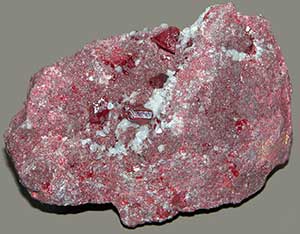 |
| Cinnabar - HgS. |
Mercury is the only common metal that is liquid at room temperature. It occurs either as a native metal or in cinnabar, corderoite, livingstonite, and other minerals. Mercury has uniform volumetric thermal expansion and good electrical conductivity and easily forms amalgams with almost all common metals except iron. Mercury is mined in Algeria, Peru, Spain, and the Western United States. It is used in the production of caustic soda and chlorine, dental amalgam, and electrical switches and relays.
Background
Mercury, known since ancient times, is a heavy, silvery, metallic mineral. Its atomic number is 80. It is liquid at room temperature. Only two other elements (cesium and gallium) are liquid at room temperature. Mercury becomes solid at -40° F (-40° C). It is dense and heavy, with a specific gravity of 13.6. For comparison, iron has a specific gravity of 7.5.
Name
The term "native mercury" is used for natural mercury found associated with the mineral cinnebar. Mercury was named after the planet Mercury that was named after the Roman god of travel. Mercury is also known by the popular name of quicksilver, derived from the Greek words, hydros meaning water, and argyros meaning silver, because this silvery mineral occurs at room temperature as a liquid. The symbol for mercury, Hg, was derived from the name, hydrargyrum.
Sources
Native mercury is found in association with its ore mineral, cinnabar. In the United States, mercury was mined in California, Arkansas, Oregon, Nevada, Idaho, and Texas, but these deposits are no longer mined. Major world producers of mercury are Algeria, Kyrgyzstan, Spain and China. The United States imports much of the mercury it needs each year.
Mercury vapor has been found to be extremely toxic. New laws, in the United States, call for reductions in mercury emissions from smokestacks and carefully controlled disposal of waste mercury and mercury compounds.
The demand for mercury has declined in the past years because of new technologies and environmental laws. Some of the demand has been met by the recycling of mercury from obsolete or worn out machines, scientific apparatus, and batteries. It is also recovered as a by-product from gold mining operations in California, Nevada, and Utah. Historically, mercury was used to obtain gold from placer gold deposits but this process is no longer used in the United States and many other countries. This process is still used by some operators in a few other countries, but the practice is disappearing.
Uses
Mercury is used to manufacture chlorine and caustic soda (35%). Because it is a metal, mercury conducts electricity making it useful in electronics and electrical applications (30%). Mercury, for example, is necessary in fluorescent light tubes. Mercury was an important ingredient in batteries, but newer types of batteries use other metals. The remaining 35% of mercury usage is in scientific measuring instruments such as thermometers and barometers, and is combined with other metals and used for in fillings for teeth (called amalgams by dentists).
Biological Interactions
Mercury vapor is a neurotoxin, which means it affects the nervous system. Once mercury is in the body, it causes nervousness, trembling, personality changes, and in extreme cases, even dementia. Fish that ingest mercury compounds that may occur in streams and lakes can become a source of mercury poisoning in humans. Consequently, the United States has enacted many strict laws to guarantee the proper and safe disposal of all mercury and mercury compounds.
Substitutes and Alternative Sources
Mercury is being used less in batteries as new types of batteries are developed, such as zinc-air, lithium and nickel-cadmium (also called Ni-Cad) batteries. Ceramics have lately been used in dental work instead of the mercury amalgams. Electronic digital instruments are used more frequently in place of mercury thermometers and barometers.